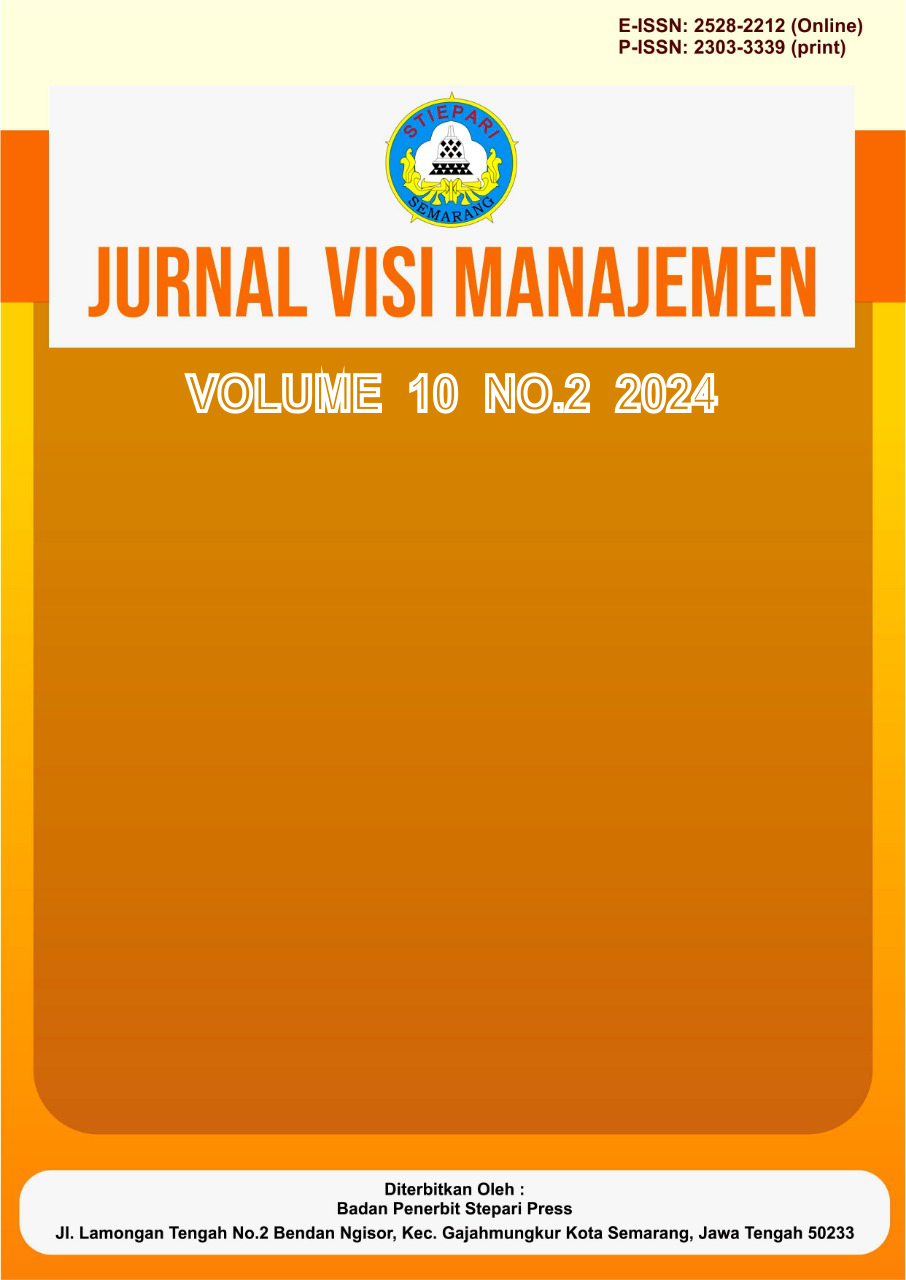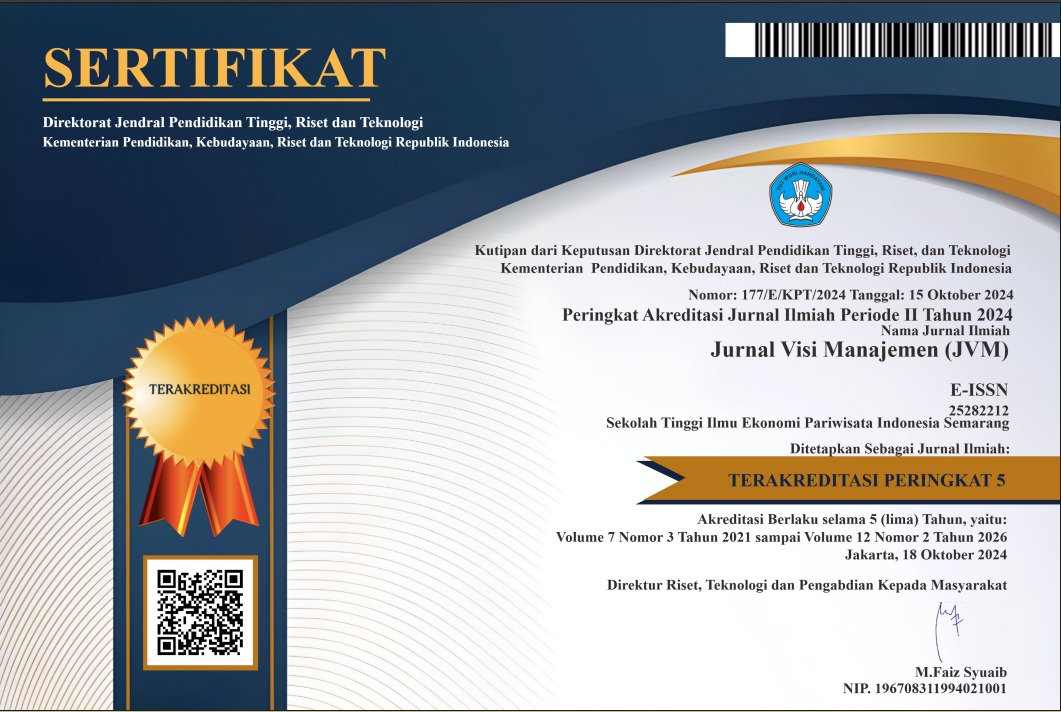Hubungan Antara Big Baths, Tata Kelola Perusahaan, dan Asimetri Informasi Terhadap Biaya Audit
DOI:
https://doi.org/10.56910/jvm.v10i2.524Keywords:
Big Bath Accounting, Corporate Governance, Information Asymmetry, Audit Fees, Literature ReviewAbstract
This study aims to analyze the relationship between big bath accounting, corporate governance, and information asymmetry on audit fees through a qualitative literature review approach. Big bath accounting, a practice of manipulating earnings by reducing profits in one period to boost profits in the subsequent period, is known to increase audit risks, which subsequently leads to higher audit fees. Strong corporate governance is believed to mitigate the negative impact of this practice by providing more effective internal controls and reducing the level of information asymmetry. Low information asymmetry between management and shareholders reduces the auditor's uncertainty regarding the quality of financial statements, which can help lower audit fees. This study reviews recent literature on the relationship among these three variables, comparing findings from previous studies to provide a deeper and more comprehensive understanding. The study's findings suggest that good corporate governance and high levels of transparency play an important role in reducing audit fees caused by big bath accounting practices and information asymmetry. These findings are expected to contribute to the development of more effective governance policies that enhance financial transparency and control audit costs.
References
Abbott, L. J., Parker, S., & Peters, G. F. (2006). Earnings management, litigation risk, and asymmetric audit fee responses. Auditing: A Journal of Practice & Theory, 25(1), 85–98.
Ali, A., & Zhang, W. (2015). CEO tenure and earnings management. Journal of Accounting and Economics, 59(1), 60–79.
Amelia, Y., & Khoerunnisya, A. (2022). Pengaruh Book Tax Differences, Arus Kas Operasi Dan Debt To Total Assets Ratio Terhadap Earnings Management. Studia Ekonomika, 16(2), 97–112. https://doi.org/10.70142/studiaekonomika.v16i2.93
Armstrong, C. S., Blouin, J. L., Jagolinzer, A. D., & Larcker, D. F. (2015). Corporate governance, incentives, and tax avoidance. Journal of Accounting and Economics, 60(1), 1–17.
Beasley, M. S., Carcello, J. V., Hermanson, D. R., & Neal, T. L. (2021). Corporate governance and audit fees: The moderating effect of board independence. Journal of Accounting Research, 59(3), 679–710.
Behn, B. K., Choi, J. H., & Kang, T. (2008). Audit quality and properties of analyst earnings forecasts. The Accounting Review, 83(2), 327–349.
Booth, A., Sutton, A., & Papaioannou, D. (2016). Systematic Approaches to a Successful Literature Review. Sage.
Burgstahler, D., Jiambalvo, J., & Shevlin, T. (2002). Do stock prices fully reflect the implications of special items for future earnings? Journal of Accounting Research, 40(3), 585–612.
Cao, Y., Myers, L. A., & Omer, T. C. (2021). Information asymmetry and audit fees: A meta-analysis. Review of Accounting Studies, 26(1), 33–62.
Carcello, J. V., Hermanson, D. R., & Ye, Y. (2020). Big bath accounting and audit quality: The role of board monitoring. Contemporary Accounting Research, 37(1), 418–445.
Chen, G., Firth, M., Gao, D. N., & Rui, O. M. (2021). The impact of corporate governance on audit fees: A multi-country analysis. International Journal of Auditing, 25(4), 512–529.
Choi, H., Karim, K., & Zhang, Y. (2023). Earnings management risk and audit pricing: Evidence from big bath accounting. Journal of Business Finance & Accounting. https://doi.org/10.1111/jbfa.12764.
Christensen, T. E., Paik, G. H., & Stice, E. K. (2008). Creating a bigger bath using the deferred tax valuation allowance. Journal of Business Finance & Accounting, 35(5-6), 601–625.
DeFond, M. L., & Zhang, J. (2019). A review of archival auditing research. Journal of Accounting and Economics, 58(2–3), 275–326.
DeFond, M., & Zhang, J. (2014). A review of archival auditing research. Journal of Accounting and Economics, 58(2-3), 275–326.
Elo, S., & Kyngäs, H. (2008). The qualitative content analysis process. Journal of Advanced Nursing, 62(1), 107–115.
Feldmann, D. A., Read, W. J., & Abdolmohammadi, M. J. (2009). Financial restatements, audit fees, and the moderating effect of CFO turnover. Auditing: A Journal of Practice & Theory, 28(1), 205–223.
Gul, F. A., Fung, S. Y. K., & Jaggi, B. (2009). Earnings quality: Some evidence on the role of auditor tenure and auditors’ industry expertise. Journal of Accounting and Economics, 47(3), 265–287.
Hart, C. (2018). Doing a Literature Review: Releasing the Research Imagination. Sage.
Healy, P. M., & Palepu, K. G. (2001). Information asymmetry, corporate disclosure, and the capital markets: A review of the empirical disclosure literature. Journal of Accounting and Economics, 31(1-3), 405–440.
Heeick, C., Karim, K., & Zhang, Y. (2023). Earnings management risk and audit pricing: Evidence from big bath accounting. Journal of Business Finance & Accounting. https://doi.org/10.1111/jbfa.12764.
Hope, O. K., & Wang, J. (2018). Management deception, big-bath accounting, and information asymmetry: Evidence from linguistic analysis. Accounting, Organizations and Society, 70, 33–51.
Jensen, M. C., & Meckling, W. H. (2022). Theory of the firm: Managerial behavior, agency costs, and ownership structure. Journal of Financial Economics, 3(4), 305–360.
Jiang, L., Liu, X., & Zhang, Y. (2023). Corporate governance and audit fees: A review and synthesis of the literature. Asian Review of Accounting, 31(1), 117–142.
Jordan, C. E., & Clark, S. J. (2015). Do Canadian companies employ big bath accounting when recording goodwill impairment? International Journal of Economics and Finance, 7(9), 159–168.
Kasih, E. W., & Estiana, D. (2022). Analisis Faktor-Faktor Yang Mempengaruhi Audit Timeliness Pada Perusahaan Sektor Perbankan Yang Terdaftar Di BEI (2012-2014). Studia Ekonomika, 15(1), 17–32. https://doi.org/10.70142/studiaekonomika.v15i1.83
Kim, S., & Yi, C. H. (2020). Auditor risk assessment and big bath accounting. Accounting, Organizations and Society, 84, 101126.
Li, H., Zhang, X., & Zhao, L. (2021). Big bath and audit fees: Evidence from global markets. Journal of International Accounting Research, 20(3), 45–67.
Ruslaini, R., Chaidir, M., & Nofita, N. (2022). Analisis Faktor-Faktor Yang Mempengaruhi Audit Delay. Studia Ekonomika, 12(1), 51–61. https://doi.org/10.70142/studiaekonomika.v12i1.45
Snyder, H. (2019). Literature review as a research methodology: An overview and guidelines. Journal of Business Research, 104, 333–339.
Tranfield, D., Denyer, D., & Smart, P. (2003). Towards a methodology for developing evidence-informed management knowledge by means of systematic review. British Journal of Management, 14(3), 207–222.
Watts, R. L., & Zimmerman, J. L. (1983). Agency problems, auditing, and the theory of the firm: Some evidence. The Journal of Law and Economics, 26(3), 613–633.
Xiao, Y., & Watson, M. (2019). Guidance on conducting a systematic literature review. Journal of Planning Education and Research, 39(1), 93–112.
Yin, R. K. (2018). Case Study Research and Applications: Design and Methods. Sage.







